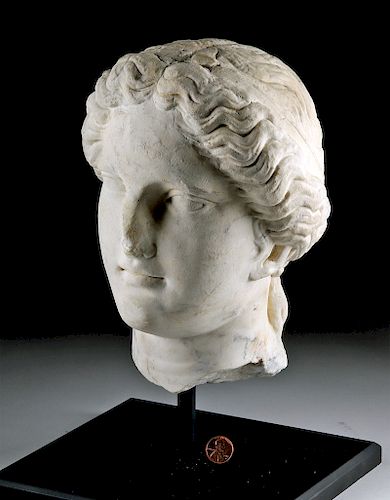Lifesize Roman Marble Head of Venus
Lot 56a
About Seller
Artemis Gallery
686 S Taylor Ave, Ste 106
Louisville, CO 80027
United States
Selling antiquities, ancient and ethnographic art online since 1993, Artemis Gallery specializes in Classical Antiquities (Egyptian, Greek, Roman, Near Eastern), Asian, Pre-Columbian, African / Tribal / Oceanographic art. Our extensive inventory includes pottery, stone, metal, wood, glass and textil...Read more
Estimate:
$15,000 - $20,000
Absentee vs Live bid
Two ways to bid:
- Leave a max absentee bid and the platform will bid on your behalf up to your maximum bid during the live auction.
- Bid live during the auction and your bids will be submitted real-time to the auctioneer.
Bid Increments
| Price | Bid Increment |
|---|---|
| $0 | $25 |
| $300 | $50 |
| $1,000 | $100 |
| $2,000 | $250 |
| $5,000 | $500 |
| $10,000 | $1,000 |
| $20,000 | $2,500 |
| $50,000 | $5,000 |
| $100,000 | $10,000 |
| $200,000 | $20,000 |
About Auction
By Artemis Gallery
Feb 21, 2019
Set Reminder
2019-02-21 10:00:00
2019-02-21 10:00:00
America/New_York
Bidsquare
Bidsquare : Exceptional Antiquities, Asian, Ethnographic
https://www.bidsquare.com/auctions/artemis-gallery/exceptional-antiquities-asian-ethnographic-3858
An important one-day auction featuring museum-worthy examples of Egyptian, Greek, Roman, Etruscan, Near Eastern, Far East / Asian, Pre-Columbian, African / Tribal, Oceanic, Native American, Spanish Colonial, Russian, Fossils, Ancient Jewelry, Fine Art, so much more! Artemis Gallery info@artemisgallery.com
An important one-day auction featuring museum-worthy examples of Egyptian, Greek, Roman, Etruscan, Near Eastern, Far East / Asian, Pre-Columbian, African / Tribal, Oceanic, Native American, Spanish Colonial, Russian, Fossils, Ancient Jewelry, Fine Art, so much more! Artemis Gallery info@artemisgallery.com
- Lot Description
Roman, Hellenistic period, ca. 2nd to 3rd century CE. A marvelous head of life-size proportions, hand-carved from creamy white marble with natural veins of pale-beige and dark-grey hues, depicting Venus (Greek Aphrodite), the goddess of love, passion, and romance. Her head is tilted slightly to the left in an inquisitive manner, her attractive coiffure parted at the center and swept back along the contours of her diadem. Piercing almond-shaped eyes beneath plateaued brows, a slender nose, naturalistic lips with indented corners, and gently-tapering cheeks constitute her feminine visage, all beneath wavy locks which are meticulously delineated and arranged in a twist that resolves in two flowing tresses at the nape of her neck. Custom museum-quality display stand included. Size: 6.25" W x 9" H (15.9 cm x 22.9 cm); 11.8" H (30 cm) on included custom stand.
The goddess' elegant, oval face is sensitively modeled to present a naturalistic visage characteristic of the Hellenistic period with a rounded forehead, large and generously lidded almond-shaped eyes, a fine brow line that arches gracefully and merges with the bridge of her nose, a soft rounded chin, and full, bow-shaped, pursed lips. Worth noting are the lovely ripples of skin on her neck, an indication that Classical beauty standards were very different from our modern ultra-thin supermodel ideal.
Take another look at Praxiteles' infamous "Aphrodite of Knidos" (ca. 360-330 BCE) and you will see that she has a soft belly and several dimples on her back. What's more, the anatomy of the "Lely's Venus" (ca. 100 to 199 CE) also displays voluptuous folds and rolls. No doubt both ancient depictions were important influences on the Baroque artist Peter Paul Rubens (Flemish, 1577-1640) who was famous for his sensual paintings of plump ladies with several chins. A breathtaking sculptural representation of the goddess whose sublime beauty legendarily inspired much rivalry among the gods, not to mention countless depictions throughout art history, among the most famous, the Renaissance artist Sandro Botticelli's "Birth of Venus" (1484-86), Baroque artist Peter Paul Rubens' "Judgement of Paris" (ca. 1636), and of course, Attic sculptor Praxiteles' "Aphrodite of Knidos" (ca. 360-330 BCE) and the equally famous "Lely's Venus" (ca. 100 to 199 CE).
A stylistically-similar example of a slightly-larger size hammered for $112,500 at Christie's, New York Antiquities auction (sale 12256, April 12, 2016, lot 53): https://www.christies.com/lotfinder/ancient-art-antiquities/a-roman-marble-head-of-venus-circa-5984801-details.aspx?from=searchresults&intObjectID=5984801&sid=c84dc44d-3d2b-4881-93cc-2eb5078d262e
Provenance: private East Coast, USA collection; ex-Artemis Gallery; ex-private Michaelsen collection, Seattle, Washington, USA
All items legal to buy/sell under U.S. Statute covering cultural patrimony Code 2600, CHAPTER 14, and are guaranteed to be as described or your money back.
A Certificate of Authenticity will accompany all winning bids.
We ship worldwide and handle all shipping in-house for your convenience.
#140431This head was exposed to salt over a very long period from exposure to sea water or an environment high in evaporated salt. As a result, it had become very fragile with the surface developing an almost chalky texture. It has been soaked in distilled water for an extended period since it has come into our possession. It was then stabilized with a light polymer solution. It is now far more stable. Losses to nose and neck line, with small repair to top of head. Light earthen deposits throughout.Condition
- Shipping Info
-
All shipping is handled in-house for your convenience. Your invoice from Artemis Gallery will include shipping calculation instructions. If in doubt, please inquire BEFORE bidding for estimated shipping costs for individual items.
-
- Buyer's Premium



 EUR
EUR CAD
CAD AUD
AUD GBP
GBP MXN
MXN HKD
HKD CNY
CNY MYR
MYR SEK
SEK SGD
SGD CHF
CHF THB
THB














